srImathE rAmAnujAya nama:
srImadh varavaramunayE nama:
srI vAnAchala mahAmunayE nama:
gOpAlakrishNa dhAsar (kOnAr) who was living in chennai and a sishya of
kOil kandhAdai vAdhUla aNNan swamy compiled a set of beautiful
phrases/sentences from nampiLLai‘s eedu (documented by vadakku thiruvIdhi piLLai) vyAkyAnam long ago. kOil vidhwAn srI U. vE. R
narasimhAchAryar swamy (paramapadhavAsi) wrote simple thamizh meanings
for those phrases/sentences. This book (https://docs.google.com/file/d/0ByVemcKfGLucbWJNTUMzVS1KTzA/edit?usp=sharing) was originally released on 7-1-68 and
was re-published by puthur raghurAman swamy (editior: srI sailEsa
dhayApAthram magazine). In this series we are relishing this great compilation with the english translation for the same.

piLLai lOkAchAryar highlights the same principle in mumukshuppadi sUthram 177. Let us see that with mAmunigaL‘s beautiful commentary.
sEshikku adhisayaththai viLaikkai sEshabUthanukku svarUpalAbamum prApyamum.
சேஷிக்கு அதிசயத்தை விளைக்கை சேஷபூதனுக்கு ஸ்வரூபலாபமும் ப்ராப்யமும்.
To bring about glories to the master will establish the true nature of the servant and is also the ultimate goal for the servant.
When the acts of the servant does not bring about happiness to the master, there is no true servitue. So, to establish ones own identity as a servant and to bring about happiness to the master, the servant should engage in service that brings about more glories to the master.
jIvAthmAs in samsAram (material world) desire to reach paramapadham (spiritual world) to enjoy bhagavAn‘s supremacy. The residents of paramapadham descend to samsAram to enjoy the simplicity/magnanimity of bhagavAn.
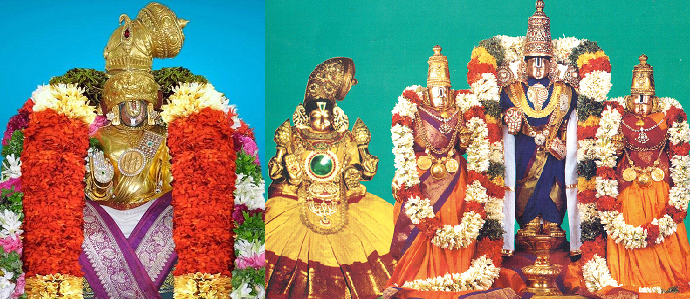
bhagavAn‘s sauseelyam and saulabhyam are fully manifested in this world. In ozhivil kAlam padhikam, nammAzhwAr longs to serve emperumAn. emperumAn at once says “AzhwAr, even nithyasUris come down here to enjoy my sauseelyam (magnanimity). So why dont you come and serve me here?”. nammAzwAr understands that and fully glorifies thiruvEnkatamudaiyAn and performs vAchika kainkaryam (service through words) to thiruvEnkatamudaiyAn.
Translator’s note: already explained in 141… series

jIvAthmA is uniquely identified by its gyAnam (knowledge) and Anandham (bliss). Yet, those attributes does not highlight the true nature of jIvAthmA. sEshathvam (being a servitor of bhagavAn) is that which highlights the true nature of jIvAthmA. sEshathvam is more important than gyAnam and Anandham.
emperumAn reveals the true nature of himself in the first 2.5 pAsurams. In the remaining 7.5 pAsurams, he reveals the true nature of the jIvAthmA. In the second pAsuram, nammAzhwAr says “adiyEn uLLAn udal uLLAn” (அடியேன் உள்ளான் உடல் உள்ளான்) – which means bhagavAn is within the soul and the body. To identify the soul, AzhwAr uses the term adiyEn – which means dhAsan (servitor) instead of “me”. A beautiful incident is narrated by nampiLLai in the eedu vyAkyAnam for this pAsuram. When emperumAnAr is explaining the nature of jIvAthmA to his sishyas, a question arises about the true nature of jIvAthmA. emperumAnAr desires to establish the truth through the words of thirukkOshtiyUr nambi (one of his own AchAryas) and thus asks AzhwAn to go and enquire the true nature of jIvAthmA from thirukkOshtiyUr nambi. AzhwAn goes to thirukkOshtiyUr and serves nambi patiently. Finally after 6 months, nambi enquires AzhwAn the purpose of his visit. AzhwAn explains the question and nambi at once says “AzhwAr says ‘adiyEn uLLAn‘” and AzhwAn immediately understands the meaning and returns to emperumAnAr to share the same with him and the gOshti. so adiyEn (being a servitor) is the primary identity of a jIvAthmA.
piLLai lOkAchAryar also establishes that sEshathvam is the distinguishing factor for the jIvAthmA and is the true nature of the jIvAthmA in his mumukshuppadi thirumanthra prakaraNam in a series of sUthrams. mAmunigaL quotes many pramANams from sAsthram such as “Athma dhAsyam harEs svAmyam svabhAvam cha sadhAsmara” (ஆத்ம தாஸ்யம் ஹரேஸ் ஸ்வாம்யம் ஸ்வபாவம் ச ஸதாஸ்மர), etc.
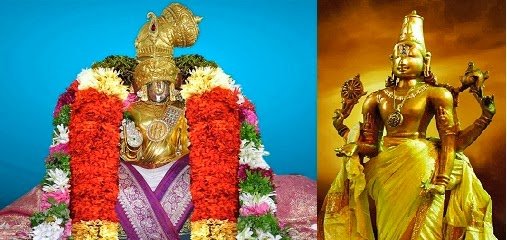
For a jIvAthmA, more than bhagavAn‘s svarUpam, bhagavAn’s divine auspicious forms are enjoyable. Similarly, for bhagavAn, more than nammAzhwAr‘s (the jIvAthmA) true nature, nammAzhwAr‘s divine form is the object of enjoyment, even though AzhwAr himself wants to give up his body and reach paramapadham. As a presumptuous (prideful) person would enjoy the dirt/sweat of his/her lovable companion, emperumAn/jIvAthmA enjoy the body (divine form) of each other.
Translator’s note: Our pUrvAchAryas have had great attachment towards emperumAn’s divine and auspicious forms. They have given greater importance to the divine forms of emperumAn over the true nature of emperumAn. nammAzhwAr identifies that emperumAn is saguNa brahmam in the first pAsuram itself.Similarly,
emperumAn also likes the divine/auspicious form of nammAzhwAr (and other AzhwArs). This is why, towards the end of thiruvAimozhi, in 10.7 “chenjoR kavigAL” (செஞ்சொற் கவிகாள்) padhigam, nammAzhwAr insists that thirumAlirunchOlai emperumAn should give up his attachment towards AzhwAr’s divine form since it is to be given up in this material world itself – but emperumAn does not want to leave that divine form of AzhwAr behind – instead he wants to bring AzhwAr with his body as is to paramapadham.This principle is beautifully explained in srIrAmAyaNam and brilliantly explained by our
piLLai lOkAchAryar and mAmunigaL in srIvachanabhUshaNa dhivya sAsthram sUthram 166.‘snAnam rOsha janakam’ engiRa vArththaiyai smarippathu.
mAmunigaL beautifully explains the different questions that arise in this case. Let us see that to understand the brilliance of mAmunigaL.
- At first, srI rAma himself instructs vibhIshaNAzhwAn to bring sIthA pirAtti after getting her bathed and cleansed – but he says that just to say auspicious words (instead of saying bring her in the dirt covered form).
- vibhIshaNAzhwAn does not understand emperumAn’s desire and so he goes to pirAtti and insists her to bathe and clean herself.
- pirAtti at first refuses but gives up due to vibhIshaNAzhwAn insisting her. But here mAmunigaL identifies that even though pirAtti understands srI rAma’s desire, she disregards that.
- Really, srI rAma wanted to see her as she was – but that did not happen. This is why he became angry that his desire was not fulfilled. So his anger is justified.
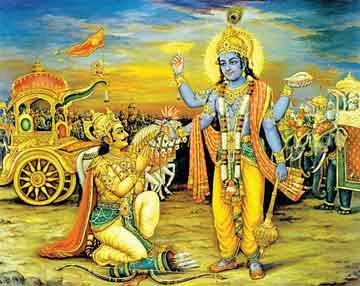
Translator’s note: There are certain essential principles to be understood. These essential principles include:
- paramAthmA and jIvAthmA are distinct entities – they are not the same.
- there are innumerable jIvAthmAs and each one is distinct (while they all have a common nature)
- all jIvAthmAs are eternally subservient to paramAthmA. The purpose of jIvAthmAs existence is to please emperumAn who is their master.
kaNNan emperumAn engages arjunan in a divine conversation amidst the battlefield. This divine conversation results in the most divine gIthA sAsthram. While arjunan was bewildered seeing his own kith and kin in the opposing side of the battle field, he fully surrenders to emperumAn and requests him to guide him properly. krishNa starts speaking about the essential truths and right in the first slOkam he explains the most important principles of our sath sampradhAyam.
ந சைவ ந பவிஷ்யாம: ஸர்வே வயம் அத: பரம்
emperumAnAr in his gIthA bhAshyam beautifully brings out the brilliance of emperumAn in establishing the most important principles in a simple slOkam.
- First, by distinguishing between himself and arjuna (I – you), bhagavAn establishes that jIvAthmA is different from paramAthmA.
- By separately identifying arjuna and all the kings, he establishes that there are many jIvAthmAs and they are all distinct.
- By saying you and the kings existed before and will exist after – he establishes that the current body of every of AthmA is temporary and the soul is permanent. As the body perishes eventually is a well-known fact (we dont need sAsthram to understand this – prathyaksham is sufficient), the body cannot be identified as always existing. So, AthmA’s permanent nature is established here.
- By taking up the position of an AchArya, he demonstrates that he is superior and jIvAthmAs are subservient to him. He also demonstrates his supremacy subsequently by manifesting virAt rUpam, etc.
157. illaiyallarAy uLarAy iruppar Asritharkku, illaiyAgiyE uLarAy iruppar anAsritharkku.
For his devotees (who accept him and surrender unto him), emperumAn manifests himself and establishes the meaning for “asthi” (existence). The ones who dont want to serve bhagavAn would say he does not exist. For such persons, emperumAn manifests himself and establishes the meaning for “nAsthi” (non-existence).
Translator’s note: In thiruvAimozhi 1.1.9 pAsuram, nammAzhwAr brings out this beautiful aspect. Let us see that here.
uLan enil uLan avan uruvam ivvuruvugaL
uLan alan enil avan aruvam ivvaruvugaL
uLan ena ilan ena ivai guNam udaimaiyil
uLaniru thagaimaiyodu ozhivilan parandhE
உளன் எனில் உளன் அவன் உருவம் இவ்வுருவுகள்
உளன் அலன் எனில் அவன் அருவம் இவ்வருவுகள்
உளன் என இலன் என இவை குணம் உடைமையில்
உளனிரு தகைமையொடு ஒழிவிலன் பரந்தே
Simple translation (Closely following vAdhikEsari azhagiya maNavAL jIyar‘s 12000 padi word-to-word vyAkyAnam): AzhwAr’s own view (in line with sAsthram – based on bhagavAn’s blessing of divine blemishless knowledge to AzhwAr) is “bhagavAn exists”. Others (avaidhikas) view is “bhagavAn does not exist”. But in either case, to establish the existence or non-existence of bhagavAn, one must accept that there is a supreme entity (If some one needs to say “krishNa does not exist”, only if an entity named krishNa can be explained, that entity’s non-existence can be proved). So, bhagavAn exists everywhere (omnipresent) and by that virtue – bhagavAn can be explained as the manifested entity (one with form/attributes) and the unmanifested entity (one without any form/attributes). As he is the focus of everything, his nature with form or without form can only be explained based on that bhagavAn who exists everywhere.
piLLai lOkAchAryar explains the principle of antharyAmithvam (omni-presence of bhagavAn) in thathva thrayam – Isvara prakaraNam (section explaining bhagavAn’s nature and glories). Here, in sUthrams 198 and 199, he highlights that bhagavAn’s antharyAmithvam is of two types:
- emperumAn being present within every entity in a state which cannot be perceived by our senses
- emperumAn being present with a divine form in the hearts of yOgis – the form on which the yOgis can concentrate and perform their upAsanam (dhyAnam, etc).
Translator’s note: When the word “nama:” is split into two – we have two letters na and ma: – here ma: means “for me” and na negates that, i.e., “not for me”. piLLai lOkAchAryar beautifully explains the “nama:” shabdham in mumukshuppadi. Let us see the highlights of the divine explanations with mAmunigaL‘s precise commentary.
- sUthram 79 – ‘ma:’ engiRa iththAl, ‘thanakku uriyan’ engiRathu; ‘na’ enRu aththaith thavirkkiRathu.(‘ம:’ என்கிற இத்தால், ‘தனக்கு உரியன்’ என்கிறது; ‘ந’ என்று அத்தைத் தவிர்க்கிறது) – ma: means “for me” (sixth case in samskritham) which indicates once servitorship towards oneself; na in samskritham is used for negation generally – so it removes ones servitorship for oneself.
- sUthram 80 – Aga ‘nama:’ engiRa iththAl, ‘thanakku uriyananRu’ engiRathu (ஆக ‘நம:’ என்கிற இத்தால், ‘தனக்கு உரியனன்று’ என்கிறது) – Thus, through “nama:” it is established that the jIvAthmA is not for himself.
- sUthram 81 – piRarkku uriyanAna anRu than vailakshaNyaththaik kAtti mItkalAm. thanakkennumanRu yOgyathaiyum kUda azhiyum (பிறர்க்கு உரியனான அன்று தன் வைலக்ஷண்யத்தைக் காட்டி மீட்கலாம். தனக்கென்னுமன்று யோக்யதையும் கூட அழியும்). – A very important aspect is addressed here. Here in nama: emphasis is on “one being not a servitor of oneself” (there is no explicit mention about jIvAthmA being a servitor of some one other than bhagavAn). It is explained that, when jIvAthmA is serving some one other than bhagavAn, he can be explained about bhagavAn being the supreme Lord and master of all, supreme cause of all causes, etc and engage him in full service to bhagavAn. But if he is simply focussed on himself (pure selfishness) – then he will not even qualify to be engaged in bhagavAn’s service. That is why the focus is on removing one’s servitorship towards oneself.
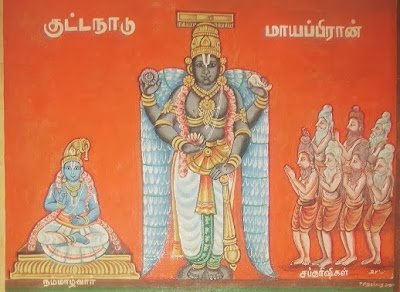
A woman who is ready to be married will belong to only one man. She neither belong to others nor belong to herself. This is the true nature. jIvAthmA’s position is also the same – he belong to bhagavAn only, no one else (including himself).
- sUthram 91 – ‘Iswaran thanakkEyAyirukkum; achiththup piRarkkEyAyirukkum; AthmA thanakkum piRarkkum pothuvAyirukkum’ enRu muRpatta ninaivu; angananRikkE achiththaippOlE thanakkEyAga enaikkoLLa vENumengiRathu namassAl (‘ஈஸ்வரன் தனக்கேயாயிருக்கும்; அசித்துப் பிறர்க்கேயாயிருக்கும்; ஆத்மா தனக்கும் பிறர்க்கும் பொதுவாயிருக்கும்’ என்று முற்பட்ட நினைவு; அங்ஙனன்றிக்கே அசித்தைப்போலே தனக்கேயாக எனைக்கொள்ள வேணுமென்கிறது நமஸ்ஸால்) – When praNavam (akAram – Aya – ukAram – makAram) is superficially understood – one will think bhagavAn is supremely independent (he will always look out for his interests), matter (devoid of knowledge) always exists for bhagavAn and jIvAthmA (makAram) will look out for self interest (due to presence of knowledge) as well bhagavAn’s desires (due to presence of servitorship). But once the real purport of “nama:” is understood, jIvAthmA will precisely understand that he should also be like matter only, i.e., look out for bhagavAn’s desires only without even a tinge of self-interest.
- sUthram 92 – athAvathu bhOga dhasaiyil Iswaran azhikkumpOthu nOkkavENumenRu azhiyAthozhigai (அதாவது போக தசையில் ஈஸ்வரன் அழிக்கும்போது நோக்கவேணுமென்று அழியாதொழிகை) – that means, when bhagavAn is accepting the jIvAthmA and wants to enjoy the jIvAthmA out of great affection, jIvAthmA should fully co-operate – even if bhagavAn wants to make the jIvAthmA superior for him and he makes himself lower than the jIvAthmA (just like a father may lift the child up and keep him on his head with great love), the jIvAthmA should not protest saying “you cannot do that because that does not fit my servitorship” – he should simply allow bhagavAn to do whatever he desires.
nammAzhwAr manifests such total dependence towards emperumAn in thiruvAimozhi – “emmA vIttuth thiRamum” (2.9) and “karumANikka malai mEl” (8.9) padhigams.
நாராயண சப்தத்துக்கு அர்த்தம் ஸ்வாமித்வ, வாத்ஸல்ய, உபாயத்வ, வ்யாபக்த்வம் இத்யாதியிறே. சதுர்த்திக்கு அர்த்தம் கைங்கர்ய ப்ரார்த்தனையிறே.
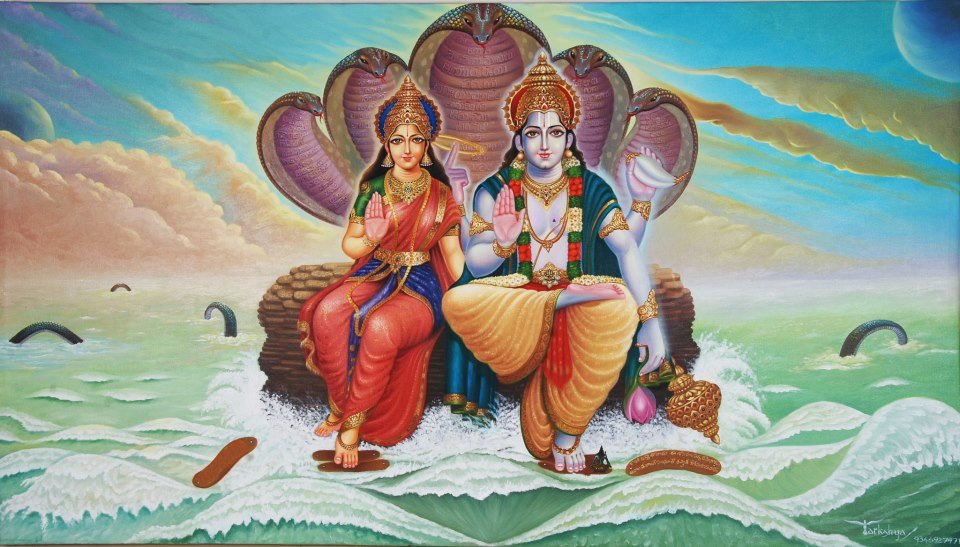
In thirumanthram, nArAyaNAya is split as nArAyaNa and Aya. nArAyaNa highlights svAmithvam (proprietorship over all jIvAthmAs and achEthanam), vAthsalyam (motherly forbearance over all jIvAthmAs and accepting their defects with joy), upAyathvam (being the means through which the ultimate goal can be attained), vyApakthvam (being omnipresent), etc. Aya (4th case in samskritham grammar) highlights the jIvAthmA’s prayer for engaging him in the service of bhagavAn.
- that everything (chith and achith) rests on bhagavAn – AdhArathvam (being the abode of everything) – this explains his parathvam (supremacy) as this quality demonstrates that he is the single entity who effortlessly supports everything that exists. Thus him being the svAmi (propreitor) of everything is established.
- that he is in everything (chith and achith) – antharyAmithvam (omnipresence) – this explains his saulabhyam (easy accessibility) – even after being the controller of everything, he mercifully stays put in each entity and guides the jIvAthmAs at every step. Thus, this demonstrates his vAthsalayam (motherly forbearance) too.
‘Aya’ highlights the jIvAthmA’s prayer towards emperumAn to engage him in all kinds of services just like Adhi sEshan is serving bhagavAn at all possible times in all possible ways.
adiyen sarathy ramanuja dasan
In hindi – https://granthams.koyil.org/2023/10/25/divine-revelations-of-lokacharya-16/